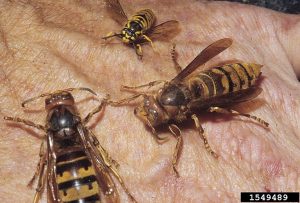Lessons Learned: The European Hornet
By Jennifer Naughton, Fairfax Master Gardener
For a vegetable gardener, nothing is as demoralizing as putting forth a Herculean effort and losing one’s entire yield. During my first year growing tomatoes, I made a novice mistake and lost a crop of Cherokee Purple to deer. After installing an 8-foot fence, I felt safer from intruders. But last summer, I faced a more challenging opponent in the garden–the European Hornet.
 The European Hornet, otherwise known as the Giant Hornet (Vespa crabro), belongs to a family of wasps called Vespids, which include yellow jackets and the bald-faced hornet. The largest in their family, the European Hornet is brown with yellow stripes on its abdomen and a pale face. Workers are 25 mm in length, and the queen is larger at 35 mm.
The European Hornet, otherwise known as the Giant Hornet (Vespa crabro), belongs to a family of wasps called Vespids, which include yellow jackets and the bald-faced hornet. The largest in their family, the European Hornet is brown with yellow stripes on its abdomen and a pale face. Workers are 25 mm in length, and the queen is larger at 35 mm.
Found in 31 states, from the Northeast, west to the Dakotas and south to Louisiana, the European Hornet nests in hollow trees or under loose tree bark and empty walls of barns, outbuildings, houses and attics. The nests are not usually free-hanging like the more well-known bald-faced hornet’s nest.
In spring, queens build nests, lay their eggs and feed their young. Over time, the young grow into workers who gather food, collect cellulose to build the nest and protect the nest from outside threats. Males and females mate in the fall and only queens survive the winter.
Colonies can contain 200 to 400 workers at their peak in September and October, which is when they are most likely to appear. Unlike most stinging insects, the European Hornets have a tendency toward nighttime activity. In the evening hours they forage and are attracted to light, repeatedly banging on lighted windows.
It was during these twilight hours and early fall (September) that I first noticed their activity in my garden. While I was collecting brown turkey figs after dinner, many over-ripe and falling to the ground, I was stung. Indeed, the European Hornet’s favorite food is fruit, as well as tree sap and honeydew. They also consume young crickets, grasshoppers, flies, yellow jackets and honey bees.
The sting is similar to that of a wasp, but hornets can sting repeatedly, secrete venom, and many can attack simultaneously. Swelling, redness, itchiness and allergic reaction are possible. My experience included all of these scenarios — I suffered from multiple stings and ended up in the doctor’s office after several days of growing inflammation to my arm. The doctor prescribed steroids and an Epi Pen. Although this was my first reaction to a sting, it could make subsequent allergic reactions more likely in the future.

European hornet stripping bark off trees
Finding the hornet’s nest is difficult, but if a nest is found, pest control services are advised rather than homeowner intervention. Plugging the entrance holes of nests may only prompt hornets to chew through interior walls to find another way out. Similarly, spraying liquid insecticides into a nest is not advised as this could encourage the hornets to make a new entrance and exit.
In my situation, I found the best course of action was prevention. By ridding my yard of overripe figs, I was able to eradicate their food source and therefore the presence of large swarms of European Hornets. Armed with a strong nozzle head attached to the garden hose, I shot at the hornets, keeping them at bay long enough to pick figs in a more timely manner. In the end, I came to an unspoken, amiable agreement with the hornets. They feasted on figs at the top, unreachable branches, and I claimed the lower ones as my own.
Although it’s too early for the European Hornet to present as a major pest, I returned to the fig tree with some trepidation this spring. A new set of problems presented itself. The fig tree was without leaf, purple and blackened at its tips. I was reminded of a line from a favorite Rudyard Kipling poem that seems especially meant for gardeners — “Watch the things you gave your life to broken … stoop and build ‘em up with worn out tools.” I reached for the bypass lopers and pruned the tree to the base, hoping for the best. The hornets may not be my biggest adversary this season.
References
European Hornet, Insect Advice from Extension, Penn State College of Agricultural Sciences
European Hornet in Kentucky, University of Kentucky Entomology